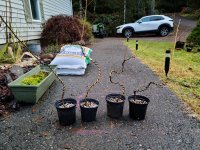Kievnstavick
Chumono
Outside of the outrageously length title (I just wanted a fun title!), welcome to the begining of the thread.
I plan to document my process, trials, and errors in this thread directly pertaining to the pursuit of growing pre-bonsai from seed as my own record as well as having a public place for others to hopefully learn from my process.
One of the biggest mysteries for me when I started growing trees from seed was how do I go from a little seedling to an amazing looking bonsai 10, 20, or 30 years in the future. There was plenty of information and guides on how to create a bonsai from nursery stock (which were already 5ish year old sticks), but a question lingered for me on what to do before then with a future bonsai in mind.
A lot of the information I found revolving around this niche part of an already niche hobby was easily summed up as "just let it grow into a tree, then work on it."
I felt that that was surely something more we could do to up to that point in order to set up a future tree to not look like a tree we gave a severe trunk chop to then grew into a bonsai.
A handful of YouTube videos I had come across gave some information, but they never really satisfied my question. They tended to give overly vague generalities that never really stuck with me despite watching them multiple times.
I was inspired by a Bonsai Wire podcast that featured Micheal Hagedorn and John Eads talking about the topic of growing trees from seed. The message that struck me was "We need more growers of quality stock." That Spring, I planted quite a bit of seeds from various species (to be posted later on) to start the growing process. I figured I would try to figure what I could on this subject while keeping my eye out for any opportunities to learn about the growing aspect of bonsai.
In hindsight, one of the things I didn't do optimally was keep my saplings in constrained environments for too long. I'll get to talking about that at a later time. My initial thought process behind it, was roots were hard to correct later down the road. So I needed to get to roots set up for success early on to create a nice radial nebari. My intent was good, but my execution could have been better.
Sometime late last year, I was once again inspired by Little Things for Bonsai People podcast speaking on a topic of learning from professionals in person. I finally decided to make the jump and joined a class being taught by John Eads on growing bonsai from seed. I can't stress enough how much doing hands on work with someone to help teach you things has helped me.
I plan to document my process, trials, and errors in this thread directly pertaining to the pursuit of growing pre-bonsai from seed as my own record as well as having a public place for others to hopefully learn from my process.
One of the biggest mysteries for me when I started growing trees from seed was how do I go from a little seedling to an amazing looking bonsai 10, 20, or 30 years in the future. There was plenty of information and guides on how to create a bonsai from nursery stock (which were already 5ish year old sticks), but a question lingered for me on what to do before then with a future bonsai in mind.
A lot of the information I found revolving around this niche part of an already niche hobby was easily summed up as "just let it grow into a tree, then work on it."
I felt that that was surely something more we could do to up to that point in order to set up a future tree to not look like a tree we gave a severe trunk chop to then grew into a bonsai.
A handful of YouTube videos I had come across gave some information, but they never really satisfied my question. They tended to give overly vague generalities that never really stuck with me despite watching them multiple times.
I was inspired by a Bonsai Wire podcast that featured Micheal Hagedorn and John Eads talking about the topic of growing trees from seed. The message that struck me was "We need more growers of quality stock." That Spring, I planted quite a bit of seeds from various species (to be posted later on) to start the growing process. I figured I would try to figure what I could on this subject while keeping my eye out for any opportunities to learn about the growing aspect of bonsai.
In hindsight, one of the things I didn't do optimally was keep my saplings in constrained environments for too long. I'll get to talking about that at a later time. My initial thought process behind it, was roots were hard to correct later down the road. So I needed to get to roots set up for success early on to create a nice radial nebari. My intent was good, but my execution could have been better.
Sometime late last year, I was once again inspired by Little Things for Bonsai People podcast speaking on a topic of learning from professionals in person. I finally decided to make the jump and joined a class being taught by John Eads on growing bonsai from seed. I can't stress enough how much doing hands on work with someone to help teach you things has helped me.


















